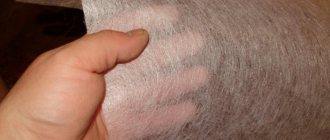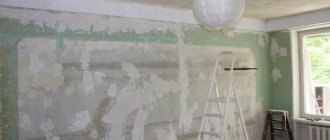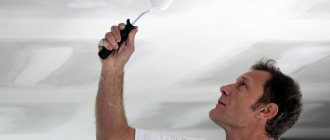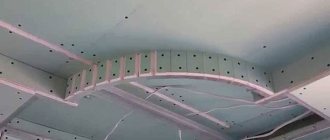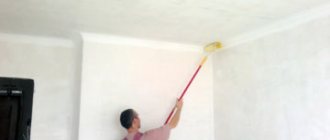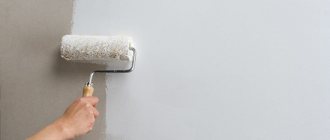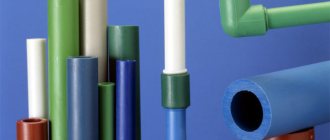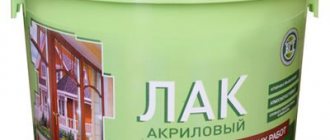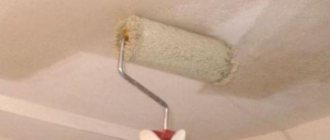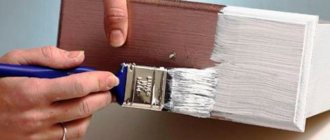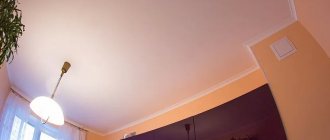Shells for stretching ceilings can be divided into 2 groups based on the material they are made of:
- from PVC (polyvinyl chloride film);
- fabric.
The canvases of these groups differ from each other not only in the numerical values of the characteristics of the same name, but also fundamentally.
An example of the difference in magnitude. The specific weight of a stretch ceiling made of polyvinyl chloride film ranges from 180 to 320 g/m² with a fabric thickness of 0.15 to 0.35 mm, and one square meter of fabric material usually weighs 200 g and has a thickness of 0.25 mm.
The fundamental differences are due to the structure of the materials. Film stretch ceilings are made from PVC film, and fabric stretch ceilings are made from knitted fabric (polyester) impregnated with polyurethane. That is, both materials are made of polymers, and the name of the “fabric” group is conditional. But in one case, polyvinyl chloride is used in the form of a film, and in the other - as an impregnation, and it is the method of using the PVC component that determines the difference in the structure and, as a consequence, the physical characteristics of the shells.
Justification for the unsuitability of PVC films for painting
Film sheets are durable and elastic - after heating, the dimensions of the film can be increased by 20% by stretching. As it cools, the canvas completely straightens, while maintaining strength, but this strength is relative. If you pour water onto a stretched shell, as happens when there is a leak from above, the film will accept it and stretch, but will not tear. However, in another situation, even a slight impact on the stretch ceiling with a sharp object, for example, when cleaning, will lead to its rupture. These properties of the film are due to the absence of reinforcement in the material.
Is it possible to paint film stretch ceilings, what will happen to the PVC film after painting? The use of water-dispersed compositions for painting is ineffective - there will be no adhesion of the paint to the surface of the stretch ceiling, and after drying it will crumble.
The consequences of using synthetic paints and varnishes when painting the entire surface of the decorative shell will be even more disastrous. Under favorable circumstances, the unreinforced film will sag under the weight of the applied layers of paint, the rigidity of which, after drying, will not allow it to straighten out. In the worst case, the paint and varnish composition will corrode the shell, and it will spread under the influence of the existing tensile force.
The film canvas can be given a second life by applying drawings using airbrushing. But, if the homeowner himself does not master this art, then the cost of services for such a design of a suspended ceiling will exceed the price of a new canvas.
Possibility of painting fabric stretch ceilings
Polyester canvas, which is the basis of a fabric stretch ceiling, after impregnation on both sides with a polymer composition, does not lose its function as reinforcement. The low elasticity of the shell in this case is an advantage - applying several layers of paint to its surface does not cause the fabric to sag.
The surface of fabric shells, due to the specifics of manufacturing technology, cannot be glossy - only matte. This texture is more difficult to clean from contamination, but it provides better adhesion of paints and varnishes to the base.
With the right choice of paint, fabric stretch ceilings can be painted repeatedly, which is what their original state is like - a white canvas, on which, depending on the model, a single-color color or artistic design is applied using photo printing or manually.
Is it possible to paint a fabric stretch ceiling?
Stretch ceilings have many important advantages over currently existing finishing options. However, even the smoothest and most flawless ceiling covering can simply become boring over the years or require cosmetic repairs. In this case, ordinary people often ask whether it is possible to paint a fabric stretch ceiling. If so, what paints can be used for this coating? Let's look at these questions in more detail.
Is it possible to paint suspended ceilings?
If you want to change the appearance of the ceiling finish or hide stubborn stains on the stretch ceiling, you will probably decide that the only solution is to completely replace the coating. However, you should not rush to spend money on a new ceiling: if you have a polyester fabric structure installed, you can simply repaint it.
Suspended plasterboard ceiling
The plasterboard ceiling just needs to be painted
Suspended ceilings made of plasterboard are in no way inferior in popularity to stretch ceilings. With their help, you can create any design on the ceiling, as well as create multi-level lighting. But now we will talk about painting the plaster ceiling. Can it be painted and what paint should I use?
Choosing paint
There are no strict criteria when choosing paint for a suspended ceiling. The only option that professionals do not recommend using is oil. It practically does not allow air to pass through, which can have a bad effect on the material. Lack of ventilation can lead to mold or mildew. This is especially true for rooms with high humidity.
It is best to pay attention to water-based or water-dispersion paints. A ceiling painted with this paint “breathes”; its composition has excellent ability to allow air to pass through. In addition, these types of coating provide a matte effect and can be washed. It is even possible to apply glossy enamel, but we do not recommend this. This paint will highlight all the imperfections of the ceiling. It is also extremely difficult to apply evenly and without drips. Enamel paints smell strong and take too long to dry, making them not a good choice.
The result of painting fabric ceilings
The high cost of fabric ceilings is due to the complexity of the structure. The polyester fabric is covered with:
- on the inside with waterproof varnish that protects against leaks from the upper floor or roof;
- on the outside, first with a dense polymer that is not afraid of damage, plus a finishing layer of varnish that gives the ceiling an excellent appearance (the varnish is practical, dust does not stick to it, dirt is easily removed).
Unlike PVC, the fabric does not sag. They produce three types of fabric texture:
- glossy ones are good because they do not fade, they look noble, but any defects on them are immediately noticeable;
- matte ones retain their color in any light, these affordable coatings are durable, but their color range is limited;
- satin is a cross between gloss and matte stretch coating; their texture imitates fabric.
The fibrous frame protects the coating from tension under the weight of the paint layer. Any type of fabric surface adheres well to painting. The only thing worth focusing on is the chemical composition of the base. Some solvents are harmful to polymers. Craftsmen recommend conducting a compatibility test: apply a drop of paint to the fabric in an inconspicuous place on the ceiling structure and leave it until dry. After this, the strength of the tension material is checked. If a small defect appears under the painted fragment, it is better not to risk it.
Suitable formulations
Let's consider the best way to paint a fabric stretch ceiling. With the right composition, the surface can be painted several times. The canvas will not sag, as the weight increases slightly. And the wrong product can damage the coating.
Stretch ceilings should be painted with water-based compounds. The best choice would be acrylic latex paint. You can also use water-based paint, but it is of good quality and has high coverage.
Compositions based on nitrocellulose or organic solvents are not used. They are too aggressive and destroy the material.
As a rule, they take white paint and then tint it in certain proportions with a suitable pigment (or several). Thanks to this, it is possible to obtain almost any shade. Just in case, it is better to purchase paint with some reserve. Finding exactly the same color will be quite difficult. If this is not possible, you need to record which pigments were added and their proportion.
Painting technology
The work process consists of preparatory work and direct application of paint to the suspended ceiling. You have to choose the right tools and materials to do the job.
Materials and tools
Water-based compositions are used to paint fabric ceilings. The best paint option is latex. Provides coating viscosity (which is important for stretched fabric) and adheres well to the surface. If latex paint is not available, a high-quality water-based paint will do. Most often, white paints are purchased for painting, which, if necessary, are tinted.
Organic-based compositions or those containing nitrocellulose are not suitable for painting ceilings. The problem here is not the blocking of pores in the base material, since any suspended ceiling is a shell impenetrable to air. Organics are not suitable for another reason: they disrupt the structure of the fabric, weakening the rigidity of the material.
It is better to use a spray gun as a working tool rather than a roller: this way the surface is treated more delicately and the paint is distributed as evenly as possible. There are many different models of spray guns on the market. It is not necessary to buy expensive pneumatic spray guns; a manual modification will do just fine.
Preparatory work
First you need to clean the surface from dust, oil stains and any other contaminants. This should be done with delicate detergents. The sponge should be soft, made of foam rubber (flannel fabric will also work).
To avoid staining anything during work, the room should be cleared of furniture and household appliances. It is recommended to cover foreign surfaces with plastic wrap or sheets of thick paper.
Drafts should be avoided in the room, so the doors to the room should be closed until the paint has completely dried. Direct sunlight should not be allowed on the freshly painted surface (windows must be curtained).
Coloring order
Stretch ceilings can be painted several times. Experts do not recommend doing this more than three times. Each layer of paint makes the canvas heavier, and as a result it can become deformed. If your room is small, you can safely paint it a maximum of three times. If the room is large, it is better not to paint the canvas more than twice.
Stages of painting D-Premium fabric stretch ceilings:
- turn off the power to the room;
- remove all furniture from it;
- Cover walls, windows, floors with oilcloth;
- cover the sockets with tape;
- stir the paint, pour it into the sprayer;
- clean the surface of dirt;
- degrease the material with a soap solution;
- apply the paint as evenly as possible;
- the direction of the first stripe is along;
- the second stripe – across;
This way you will paint the surface in the form of a checkerboard.
- It is important to paint the entire canvas at one time.
- Apply the stripes overlapping each other.
- You can paint the material in two layers, then the color will be brighter and the paint will apply more evenly.
- Follow the checkerboard pattern when painting.
- Be sure to turn off the power, otherwise you may get electrocuted.
- Cover the perimeter walls under the ceiling with tape to prevent paint from getting on them.
- If you decide not to spray paint, it is better to use a roller that is not very fluffy.
The correct choice of color for a fabric stretch ceiling affects not only the appearance of the room, but also the creation of comfort and coziness for the inhabitants of the house. It is necessary to choose such a shade that the result is a harmonious and at the same time not faceless room. To do this, the following factors should be taken into account: what the room is intended for, its style, height and area, the shade of the furniture and walls, as well as the wishes of the owners of the house.
You can only paint a suspended ceiling made of fabric yourself. To do this you will need the following tools:
- acrylic paint,
- roller
- special spray bottle.
Is it possible to paint a PVC stretch ceiling?
PVC or polyvinyl chloride is a material whose properties do not allow it to absorb and hold any type of paint on the surface. Moreover, the solvents contained in most paints and varnishes can simply corrode the canvas. After such manipulations, the canvas will need to be dismantled and replaced with a new one.
If your desire to change the color of the ceiling is irresistible, you should contact SkyPRO in St. Petersburg to replace your ceiling with a new one. Moreover, the choice of color solutions for PVC canvases is truly huge. From a financial point of view, the process of changing paintings is affordable.
It is better to paint or completely replace the ceiling
If we compare painting with a complete replacement of the canvas, then painting is an alternative to installing a new ceiling in order to save money. There is no guarantee that the paint will apply evenly, the ceiling will not sag or the new surface will not crack, since everything depends on individual factors:
- paint quality;
- canvas material;
- ceiling tension forces;
- the tool used;
- compliance with technology.
Regarding time, painting takes longer, given that when replacing, craftsmen will not have to mount a profile to secure the canvas. It is enough to remove the old material, warm the air in the room, and put on the new one. The preparation of the room is minimal - the main thing is to provide access to the ceiling around the perimeter.
The most effective, safe and easiest way to update the color of a stretch ceiling is to stretch a new fabric. For PVC film, this is, in principle, the only correct solution, since it cannot be painted. The assortment includes a wide selection of canvases in popular colors, in matte, glossy, satin finishes.
You can choose a design in dark, light, colorful, neutral colors. We have options for classic interiors, minimalism, loft, fusion, eclecticism, modern. Choose neutral options for living rooms, calm tones for bedrooms and colorful ones for children’s rooms.
Preparatory work
To ensure that repairs and painting take place with as little loss as possible, the space must be cleared of furniture before starting. If this is not possible, carefully and futilely cover it with film or paper to avoid damage or contamination.
Next, it is proposed to clean the exterior from gunpowder, dirt, old paints, stains and oils using a soft foam-based sponge, after moistening it with gentle detergents.
After applying the dye to the tension covering, it is important that the room does not receive direct sunlight and there are no drafts, so it is important to tightly close the doors in the room being treated.
If the room is large, flooring is required. The paint is applied in tears, otherwise there will be no uniform painting.
Preparing the premises
When working with a surface such as a stretched canvas, you should worry about your safety. There is electrical wiring in the ceiling space, and if you touch it, there is a risk of getting an electric shock. To avoid this, you will need to turn off the electricity in the room before starting work.
In addition, it is necessary to calculate the time in advance so that the room is light, since it will not be possible to illuminate it using the existing light bulb - the electricity will be turned off. It’s worth taking care of the necessary tools in advance.
Which paint to choose?
It is best to use acrylic paint for painting fabric coverings. It lasts the longest, is fixed, and does not require special equipment. For a more convenient and uniform application of paint, use a sprayer. You won't be able to distribute the paint evenly with a roller. A sprayer, on the contrary, will help to do this more correctly and harmoniously. Also, if you do decide to use a roller, be aware that too much paint gets on it. As a result, paint stains appear throughout the room, on your clothes, shoes. The sprayer applies the pigment in a thinner layer, which prevents it from running off.
Quite often the question is asked whether suspended ceilings are painted with water-based paint. Experts do not recommend using this type of paint for suspended ceilings. It is great for a regular ceiling, but, thanks to the same properties, it is not compatible with a stretch ceiling. Water-based paint is quite heavy, it is difficult to distribute it evenly over the surface, it leaves rather rough strokes, which can spoil the beauty of the canvas.
Care instructions
Some useful recommendations regarding painting and caring for painted stretch ceilings:
- Repainting is allowed no more than 5–6 times, since the canvas gradually stretches under the weight of the paint and varnish material, becoming unusable. If the canvas area is large, then the maximum number of colors is 3.
- When caring for the coating, you should avoid using hard-bristled brushes. Do not wash the suspended ceiling with any sharp devices.
- Solvents, alkalis, and detergents containing ammonia are not suitable for caring for painted stretch ceilings.
- Special detergents are produced for cleaning suspended ceilings. Sprays for cleaning mirrors have proven themselves well.
- If there are no specialized chemicals, ordinary laundry soap diluted in warm water will do. The soap composition is applied to the coating with progressive, but not circular movements. This avoids streaks on the surface.
- In order for the glossy surface to shine, it must be treated with a solution of ammonia (water and ammonia).
- You should not carry out wet cleaning too often, so as not to damage the paint layer. One procedure per 6-month period is sufficient.
Fabric coverings are much more expensive than film coverings. Usually we are talking about one and a half to two times the difference in price. There is nothing unusual in painting fabric material - this is a standard procedure for ceilings of this type. Even a novice master can cope with the work if he shows diligence and follows the instructions.
